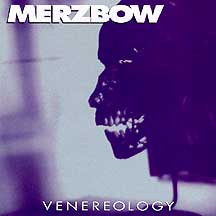Merzbox is a box set compilation by the Japanese noise musician Merzbow. It consists of 50 CDs spanning Merzbow's career from 1979 to 1997. 30 discs are taken from long out of print releases, while 20 are composed mainly of unreleased material. The box also contains two CD-ROMs, six CD-sized round cards, six round stickers, a poster, a black long-sleeve T-shirt, a medallion, and the Merzbook, all packaged together in a "fetish" black rubber box. It is limited to 1000 numbered copies. A Merzbox Sampler was released in 1997.

Venereology is an album by the Japanese noise musician Merzbow. It was inspired by death metal and grindcore.

Scissors for Cutting Merzbow is an album by the Merzbow side project SCUM. It was the last LP record released by ZSF Produkt. The project's name is a play on the SCUM Manifesto, and the track titles were influenced by American post-war art. The artwork are collages including images from Human Sex Anatomy by Robert Latou Dickinson. An expanded version was later included in the Merzbox. Some of the original studio sessions were included on Duo.

Project Frequency is an album by the Japanese noise musician Merzbow, the front of the sleeve has metal mesh attached to it.

Noisembryo, subtitled Psycho-Analytic Study of Coital Noise Posture, is an album by the Japanese musician Merzbow.

Merzbow is a Japanese noise project started in 1979 by Masami Akita. Merzbow is best known for a style of harsh, confrontational noise. Since 1980, Akita has released over 400 recordings and has collaborated with various artists.

13 Japanese Birds is a 15 album series by the Japanese noise musician Merzbow. It was inspired by Olivier Messiaen's Catalogue d'oiseaux, but has no direct musical relationship.

Protean World is an album by the Japanese noise musician Merzbow.

Hiranya is an album by Japanese noise musician Merzbow. The album was originally supposed to be released for Merzbow's appearance on May 17 at No Fun Fest in New York City, but Masami Akita cancelled his tour due to travel restrictions caused by the swine flu outbreak. The album art parodies that of Aqualung by Jethro Tull, with the human figures replaced with birds. The artwork of Graft was also inspired by a Jethro Tull record.

Microkosmos | Volume 1 is an album by the Japanese noise musician Merzbow, the first in an announced series of five. The series features artwork from a collection of visual collages created by Masami Akita from 1982–83. As of July 2016, no further volumes have been released.

Antimonument is an album by the Japanese noise musician Merzbow. It was originally released as a picture disc LP and reissued on CD by Art Directe in 1991. The CD is now considered a bootleg since the label did not pay the artists.

Merzbient is a boxed set album by the Japanese noise musician Merzbow, it is composed of previously unreleased raw material recorded 1987–90.

Kamadhenu is an album by the Japanese noise musician Merzbow. It is the first volume of the Merzcow trilogy, inspired by cattle veneration in Hinduism. The theme was suggested by the owner of the label, who visited the Care for Cows charity in Vrindavan, India, which takes care of abandoned cattle. The music is intended to be "warm and organic", and was made using granular synthesis, oscillators, and tone generators.

Storage is an album by the Japanese noise musician Merzbow. Due to issues with sound quality, the original recording was edited for this release. The original full-length recording was issued in the Merzbox in 2000. The working title for the album was War Storage, which was later used for the track titles of the Merzbox version. The full-length version was reissued as a three-sided double LP in December 2016 by Menstrualrecordings.

Uzu Me Ku is an album by the Japanese noise musician Merzbow. It features the Koto, a traditional Japanese instrument, "manipulated through granular synthesis by digital and analogue electronics devices." According to Masami Akita, "Uzume Hikoyuzu" means "spiral generating" and "Itsu Akitsu" means "generating of particles". The album photos were taken at the Nagasawa Purification Plant in Kawasaki, Japan, which was designed by Mamoru Yamada.

Samidara is an album by the Japanese noise musician Merzbow, released as both an LP and a cassette. It was made available for pre-order on December 5, 2012, but didn't start shipping until July 2013.

Takahe Collage is an album by the Japanese noise musician Merzbow. The album is named after the native New Zealand takahē bird.

Tamayodo is an album by the Japanese noise musician Merzbow. It is described as "monotonic electro pulse-noise works by all analogue equipments."

Nezumimochi is an album by the Japanese noise musician Merzbow. It is a picture disc LP and a CD set. It is described as "monotonic electro pulse-noise works by all analogue equipments."

Hatobana is a studio album by the Japanese noise musician Merzbow. It was released on October 14, 2016, by the Italian label Rustblade, and is his fifth release for the label. It was released as a double album and a deluxe edition with a bonus CD. It was originally announced for release on Noisoke Records in 2013.



















